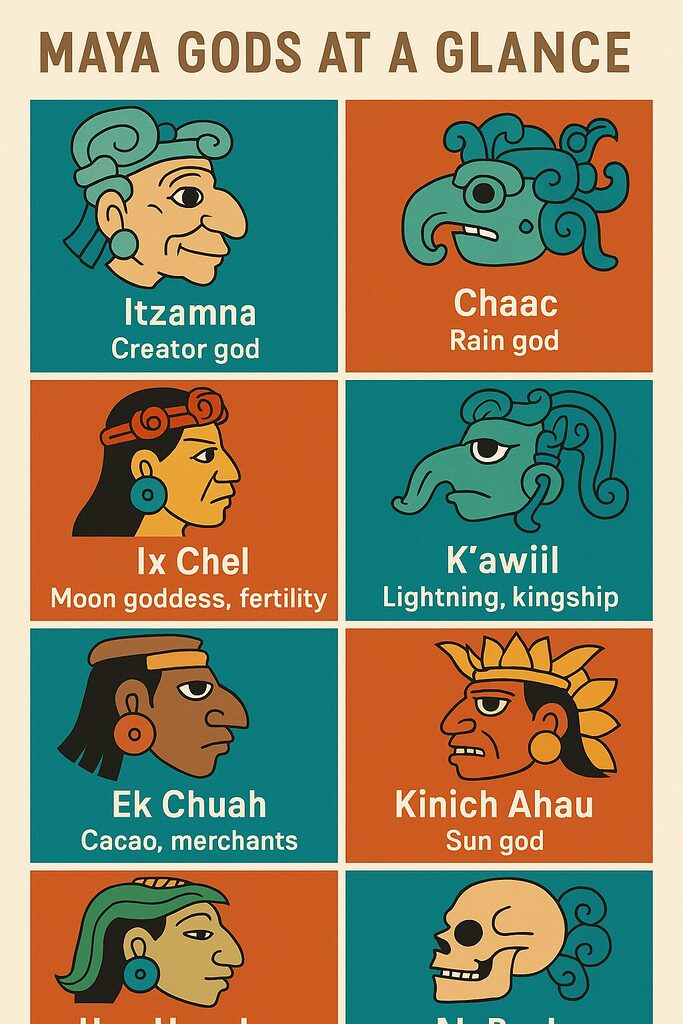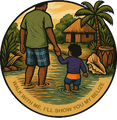The Maya Gods of Belize: Sacred Powers in Stone, Sky, and Cave
Introduction: Why the Maya Gods Still Matter
In ancient Belize, the gods were everywhere: carved in limestone, painted on pottery, and hidden deep within sacred caves. These deities weren’t just symbols. They were the life force behind timekeeping, agriculture, warfare, and creation itself. Today, their stories survive in the ruins of cities like Caracol and Lamanai—and in the rituals still practiced in Maya communities.
This post explores the major Maya gods, with special attention to those worshipped in Belize’s city-states, caves, and ceremonial plazas.
Core Maya Deities Across the Region
While local worship varied, several gods were shared across the Maya world:
| Name | Role | Symbol or Domain |
|---|---|---|
| Itzamna | Creator god, god of wisdom and writing | Sky, creation, medicine |
| Chaac | Rain god | Thunder, lightning, fertility |
| Ix Chel | Moon goddess, goddess of fertility and medicine | Weaving, childbirth, lunar cycles |
| K’awiil | God of dynastic power | Lightning, serpents, royal lineage |
| Hun Hunahpu | Maize god | Agriculture, resurrection |
| Ah Puch | Death god | Underworld, disease |
| Ek Chuah | God of cacao and trade | Commerce, travelers |
These deities appear in codices, carvings, and oral traditions from Belize to Yucatán.
Maya Gods Worshipped in Belize
Each city-state in Belize often emphasized certain gods based on their local environment, political history, or cosmic alignment.
🌍 Caracol: K’awiil and the Sun God
- Dominant Deity: K’awiil (god of lightning and royal lineage)
- Evidence: Royal stelae with serpent-foot imagery and lightning motifs.
- Notable Practices: Rituals tied to dynastic succession and katun ceremonies.
🌍 Altun Ha: The Sun God
- Dominant Deity: Kinich Ahau (Sun God)
- Evidence: Large jade head of the Sun God found in a royal tomb.
- Notable Practices: Solar alignments and deity offerings.
🌍 Lamanai: Ix Chel and Moon Cycles
- Dominant Deity: Likely Ix Chel (Moon Goddess)
- Evidence: Feminine motifs and moon glyphs in temple carvings.
- Notable Practices: Water-based rituals tied to lunar cycles.
🌍 Xunantunich: K’awiil and Calendar Gods
- Dominant Deity: K’awiil and Calendar deities
- Evidence: Iconography showing calendar rituals, serpents, and royal descent.
- Notable Practices: Public ceremonies at katun-ending stelae.
🌍 Belizean Caves (Actun Tunichil Muknal, Barton Creek Cave)
- Dominant Spirits: Chthonic deities (Ah Puch, Earth Lords, underworld guardians)
- Evidence: Human sacrifices, pottery, and natural altars.
- Notable Practices: Pilgrimages, offerings, and ancestor communication.f
How the Maya Honored Their Gods in Everyday Life
Even outside of temples and palaces, Maya life was filled with devotion to the gods. Here’s how everyday people connected with the divine:
🏡 1. Daily Offerings at Home Shrines
- Households made daily offerings of incense, food, and flowers.
- Gods like Chaac and Ix Chel were called on for rain, healing, and childbirth.
📅 2. Naming and Calendar Days
- Babies were named based on the Tzolk’in day of birth.
- Each day carried divine meaning, guiding personal destiny.
🕳️ 3. Cave Pilgrimages
- Sacred caves were portals to the underworld.
- Offerings and prayers were made to death and fertility gods.
🌽 4. Ceremonies for Agriculture
- Farmers honored Hun Hunahpu and Chaac for good crops.
- Seasonal festivals involved music, dancing, and food.
🌙 5. Healing and Midwifery
- Ix Chel was invoked by healers and midwives.
- Traditional medicine was considered spiritually guided.
👑 6. Public Rituals and Ruler Ceremonies
- Kings performed major rituals aligned with calendar cycles.
- Bloodletting, incense, and feasting connected rulers to the divine.
Even today, Maya descendants in Belize still make copal offerings, celebrate seasonal rituals, and speak the names of these gods.
Maya Myth and Sacred Landscapes
In Belize, the landscape itself mirrors the Maya worldview:
- The sky (home of Itzamna, Sun, Moon)
- The middle world (city-states, humans)
- The underworld or Xibalba (caves, death, transformation)
Many sacred sites were chosen for their alignment with solstices or cave access, directly connecting gods to physical geography.

Fun Fact: Maya Gods Are Still Honored Today
In parts of southern Belize and Guatemala, descendants of the Maya continue to honor old gods in modern ways:
- Lightning ceremonies for K’awiil
- Agricultural blessings tied to Hun Hunahpu
- Ceremonial cacao drinks in honor of Ek Chuah
Even tour guides (like me) still invoke the ancient names when walking through these sacred spaces.
If you like this fun fact about the maya, you may also want to read facts about Belize.
Final Thought: Walk Where the Gods Were Named
The Maya gods weren’t just carved in stone—they were part of daily life. As you walk through Belize’s ruins and caves, you’re retracing steps once taken by kings, scribes, and shamans invoking the divine.
Reflection: What the Maya Belief System Can Teach Us
As humans, we experience things like love, grief, joy, and pain. In many belief systems today, all good is attributed to one god, and all bad to another—or sometimes just one being for everything. But the Maya had gods for the rain, for the maize, for birth, for death—for things tied directly to the physical world around them.
It makes me wonder: if more of us today believed the way the Maya did—that rivers, storms, crops, and caves each carried their own sacred force—maybe we’d respect nature a little more.
As you walk through Belize’s ruins and caves, you’re retracing steps once taken by kings, scribes, and shamans invoking the divine.
📍 Belize With Alvin
📞 (+501) 629-5953
🌐 www.belizewithalvin.com
🗓️ Book a Tour of Belize’s Maya Ruins and Sacred Caves »

